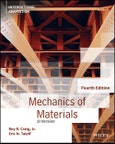Mechanics of Materials provides an in-depth yet accessible introduction to the behavior of solid materials under various stresses and strains. Emphasizing the three key concepts of deformable-body mechanics - equilibrium, material behavior, and geometry of deformation - this popular textbook covers the fundamental concepts of the subject while helping students strengthen their problem-solving skills. Throughout the text, students are taught to apply an effective four-step methodology to solve numerous example problems and understand the underlying principles of each application. Focusing primarily on the behavior of solids under static-loading conditions, the text thoroughly prepares students for subsequent courses in solids and structures involving more complex engineering analyses and Computer-Aided Engineering (CAE). The text provides ample, fully solved practice problems, real-world engineering examples, the equations that correspond to each concept, chapter summaries, procedure lists, illustrations, flow charts, diagrams, and more. This International adaptation has been thoroughly updated to use SI units. In addition to the new and updated materials, this updated edition includes new Python computer code examples, problems, and homework assignments that require only basic programming knowledge.
Table of Contents
1 INTRODUCTION
1.1 What Is Mechanics of Materials?
1.2 The Fundamental Equations of Deformable-Body Mechanics
1.3 Problem-Solving Procedures
1.4 Review of Static Equilibrium; Equilibrium of Deformable Bodies
Chapter 1 Review
Problems
2 STRESS AND STRAIN
2.1 Introduction
2.2 Normal Stress
2.3 Extensional Strain; Thermal Strain
2.4 Stress-Strain Diagrams; Mechanical Properties of Materials
2.5 Elasticity and Plasticity; Temperature Effects
2.6 Linear Elasticity; Hooke's Law and Poisson's Ratio
2.7 Shear Stress and Shear Strain; Shear Modulus
2.8 Introduction to Design-Axial Loads and Direct Shear
2.9 Stresses on an Inclined Plane in an Axially Loaded Member
2.10 Saint-Venant's Principle
2.11 Hooke's Law for Plane Stress; the Relationship Between E and G
2.12 General Definitions of Stress and Strain
*2.13 Cartesian Components of Stress; Generalized Hooke's Law for Isotropic Materials
Chapter 2 Review
Problems
3 AXIAL DEFORMATION
3.1 Introduction
3.2 Basic Theory of Axial Deformation
3.3 Examples of Nonuniform Axial Deformation
3.4 Statically Determinate Structures
3.5 Statically Indeterminate Structures
3.6 Thermal Effects on Axial Deformation
3.7 Geometric "Misfits"
3.8 Displacement-Method Solution of Axial-Deformation Problems
*3.9 Force-Method Solution of Axial-Deformation Problems
*3.10 Introduction to the Analysis of Planar Trusses
Chapter 3 Review
Problems
4 TORSION
4.1 Introduction
4.2 Torsional Deformation of Circular Bars
4.3 Torsion of Linearly Elastic Circular Bars
4.4 Stress Distribution in Circular Torsion Bars; Torsion Testing
4.5 Statically Determinate Assemblages of Uniform Torsion Members
4.6 Statically Indeterminate Assemblages of Uniform Torsion Members
*4.7 Displacement-Method Solution of Torsion Problems
4.8 Power-Transmission Shafts
*4.9 Thin-Wall Torsion Members
*4.10 Torsion of Noncircular Prismatic Bars
Chapter 4 Review
Problems
5 TRANSFORMATION OF STRESS AND STRAIN
5.1 Introduction
5.2 Plane Stress
5.3 Stress Transformation for Plane Stress
5.4 Principal Stresses and Maximum Shear Stress
5.5 Mohr's Circle for Plane Stress
5.6 Triaxial Stress; Absolute Maximum Shear Stress
5.7 Plane Strain
5.8 Transformation of Strains in a Plane
5.9 Mohr's Circle for Strain
5.10 Measurement of Strain; Strain Rosettes
Chapter 5 Review
Problems
6 EQUILIBRIUM OF BEAMS
6.1 Introduction
6.2 Equilibrium of Beams Using Finite Free-Body Diagrams
6.3 Equilibrium Relationships Among Loads, Shear Force, and Bending Moment
6.4 Shear-Force and Bending-Moment Diagrams: Equilibrium Method
6.5 Shear-Force and Bending-Moment Diagrams: Graphical Method
*6.6 Discontinuity Functions to Represent Loads, Shear, and Moment
Chapter 6 Review
Problems
7 STRESSES IN BEAMS
7.1 Introduction
7.2 Strain-Displacement Analysis
7.3 Flexural Stress in Linearly Elastic Beams
7.4 Design of Beams for Strength
7.5 Flexural Stress in Nonhomogeneous Beams
*7.6 Unsymmetric Bending
*7.7 Inelastic Bending of Beams
7.8 Shear Stress and Shear Flow in Beams
7.9 Limitations on the Shear-Stress Formula
7.10 Shear Stress in Thin-Wall Beams
7.11 Shear in Built-up Beams
*7.12 Shear Center
Chapter 7 Review
Problems
8 DEFLECTION OF BEAMS
8.1 Introduction
8.2 Differential Equations of the Deflection Curve
8.3 Slope and Deflection by Integration-Statically Determinate Beams
8.4 Slope and Deflection by Integration-Statically Indeterminate Beams
*8.5 Use of Discontinuity Functions to Determine Beam Deflections
8.6 Slope and Deflection of Beams: Superposition Method
*8.7 Slope and Deflection of Beams: Displacement Method
Chapter 8 Review
Problems
9 PRESSURE VESSELS; STRESSES DUE TO COMBINED LOADING
9.1 Introduction
9.2 Thin-Wall Pressure Vessels
9.3 Thick-Wall Pressure Vessels
9.4 Stress Distribution in Beams
9.5 Stresses Due to Combined Loads
Chapter 9 Review
Problems
10 BUCKLING OF COLUMNS
10.1 Introduction
10.2 The Ideal Pin-Ended Column; Euler Buckling Load
10.3 The Effect of End Conditions on Column Buckling
*10.4 Eccentric Loading; the Secant Formula
*10.5 Imperfections in Columns
*10.6 Inelastic Buckling of Ideal Columns
10.7 Design of Centrally Loaded Columns
Chapter 10 Review
Problems
11 ENERGY METHODS
11.1 Introduction
11.2 Work and Strain Energy
11.3 Elastic Strain Energy for Various Types of Loading
11.4 Work-Energy Principle for Calculating Deflections
11.5 Castigliano's Second Theorem; the Unit-Load Method
*11.6 Virtual Work
*11.7 Strain-Energy Methods
*11.8 Complementary-Energy Methods
Chapter 11 Review
Problems
12 SPECIAL TOPICS RELATED TO DESIGN
12.1 Introduction
12.2 Stress Concentrations
*12.3 Failure Theories
*12.4 Fatigue and Fracture
Chapter 12 Review
Problems
A NUMERICAL ACCURACY; APPROXIMATIONS
A.1 Numerical Accuracy; Significant Digits
A.2 Approximations
B SYSTEMS OF UNITS
B.1 Introduction
B.2 SI Units
B.4 Useful Physical Properties
C GEOMETRIC PROPERTIES OF PLANE AREAS
C.1 First Moments of Area; Centroid
C.2 Moments of Inertia of an Area
C.3 Product of Inertia of an Area
C.4 Area Moments of Inertia about Inclined Axes; Principal Moments of Inertia
C.5 Geometric Properties of Plane Areas
D SECTION PROPERTIES OF SELECTED STRUCTURAL SHAPES
E DEFLECTIONS AND SLOPES OF BEAMS; FIXED-END ACTIONS
F MECHANICAL PROPERTIES OF SELECTED ENGINEERING MATERIALS
G MECHANICAL PROPERTIES OF COMPOSITE MATERIALS
H POISSON'S RATIO VALUES FOR VARIOUS MATERIALS
ANSWERS TO SELECTED ODD-NUMBERED PROBLEMS
REFERENCES
INDEX








